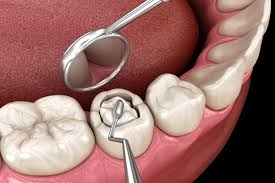Fillings are one of the most common procedures that dentists perform; you'd expect to know about them if you have gone through one or two procedures already. But what exactly is a filling? What is the dental filling cost? Are there different kinds of fillings? Most importantly, how would you know if you need one? You will find answers to all these queries in this guide so that your next dental appointment will be smooth and trouble-free.
Fillings In Dentistry
Fillings refer to therapies that are restorative and most commonly referred to as filling materials applied to areas of cavity-involved teeth to regain the function, integrity, and form of teeth affected by decay or trauma. Basically, when dentists remove a cavity (an area caused due to decay resulting in a small hole), the next step is to fill the space with material to prevent further damage, provide strength to the tooth, and stop bacteria from entering it. Dental fillings also help to maintain a normal occlusion and keep the nerve of the tooth from exposure.
Fillings are also used for sealing dental cracks or breaks, or the most common filling application that involves teeth subject to wear from habits such as nail-biting or grinding.
Types of Filling
There are various types of dental filling materials according to the needs of the dentist and the patient: the depth and location of the cavity, aesthetic preferences, and budget all influence the choice of filling type. The most common types are:
1. Amalgams
Made of silver, mercury, tin, copper, and various other metals, amalgams are very durable and, therefore, most commonly used in the back molars that can bear heavy chewing pressures. Their shiny silver color is a disadvantage, making them far from desirable in anterior teeth.
2. Fillings made from composite resinized materials can resemble the color of teeth naturally for aesthetic reasons. These are suitable for visibility, but in larger amounts, may not be as durable as amalgams.
3. Fillings in Ceramic
Porcelain ceramic fillings emphasize superior resistance to stains; therefore, they allow for color matching to that of natural teeth. They are more durable than composite fillings but tend to be more expensive.
4. Gold Fillings
Among the most durable, gold fillings can last more than 15 years. They are resistant to abrasion, but their characteristic golden color and relatively greater cost have limited their popularity.
5. Glass Ionomer Fillings
Glass ionomers are a mix of acrylic with a certain glass, which also releases fluoride for the purpose of protecting the tooth from further decay. In general, they are less durable than composite and ceramic fillings.
How Do I Know I May Need a Dental Filling?
Several signs may indicate that a filling is required. Constant toothaches, toothaches, or any pain that has no explanation would possibly be the most common sign that, due to decay, damage has occurred to the living and sensitive structures inside the tooth, thereby activating pain sensations. You can also experience some sensitivity to eating and drinking hot, cold, or sweet substances—this extraordinary amount of stimuli could indicate that the cementum or enamel of your tooth is no longer intact.
Yet another clear sign includes visible holes or dark spots. These conditions generally denote early decay/cavities that need attention before they can become worse. In either event, severe pain while biting or chewing could indicate that the tooth structure has undergone significant decay and thus requires filling or support. Visiting a dentist is indicated in the case of a chipped or broken tooth, since these minor cracks can allow for bacteria to enter and cause decay if not treated in time.
Dental Filling Procedure Explained
Fairly straightforward and not taking generally more than one hour to perform. In the beginning, an injection of local anesthetic is provided to numb the area surrounding the affected teeth so that one is comfortable during the procedure. Once the area is numb, your dentist treats the decay using special instruments- dental drills or lasers, as the situation arises.
The cavity is then cleaned sufficiently from any remnant debris or bacteria, since it is very essential to provide a proper bond between the filling and tooth, and also to avoid any possible entrapment of the infection within the teeth. Once the tooth has been cleaned and readied, the filling material that the dentist has chosen will be placed into the cavity. Special light may be used for a quick hardening and setting of the material in some cases.
Charges for Dental Filling
The charges for dental fillings depend on various factors. All these would contribute to the final cost, like filling materials, the size of the filling, location of the filling, experience of the dentist, and insurance benefits if the patient carries such. Generally, traditional materials such as amalgams are classified as the least expensive, while composite, ceramic, or gold fillings come top of the list.
So always put it in--get a quote from the dentist regarding what the material options and costs are likely to be. Most dental offices are flexible when it comes to payment plans and/or membership programs that enable one to have less expensive and more budget-friendly access to necessary treatments, such as fillings.





Comments